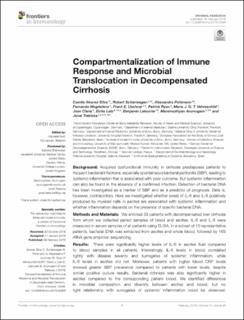| dc.contributor.author | Alvarez-Silva, Camila | |
| dc.contributor.author | Schierwagen, Robert | |
| dc.contributor.author | Pohlmann, Alessandra | |
| dc.contributor.author | Magdaleno, Fernando | |
| dc.contributor.author | Uschner, Frank Erhard | |
| dc.contributor.author | Ryan, Patrick | |
| dc.contributor.author | Vehreschild, Maria J. G. T. | |
| dc.contributor.author | Claria, Joan | |
| dc.contributor.author | Latz, Eicke | |
| dc.contributor.author | Lelouvier, Benjamin | |
| dc.contributor.author | Arumugam, Manimozhiyan | |
| dc.contributor.author | Trebicka, Jonel | |
| dc.date.accessioned | 2022-05-02T10:50:47Z | |
| dc.date.available | 2022-05-02T10:50:47Z | |
| dc.date.created | 2020-02-03T12:53:29Z | |
| dc.date.issued | 2019 | |
| dc.identifier.issn | 1664-3224 | |
| dc.identifier.uri | https://hdl.handle.net/11250/2993618 | |
| dc.description.abstract | Background: Acquired dysfunctional immunity in cirrhosis predisposes patients to frequent bacterial infections, especially spontaneous bacterial peritonitis (SBP), leading to systemic inflammation that is associated with poor outcome. But systemic inflammation can also be found in the absence of a confirmed infection. Detection of bacterial DNA has been investigated as a marker of SBP and as a predictor of prognosis. Data is, however, contradictory. Here we investigated whether levels of IL-6 and IL-8 putatively produced by myeloid cells in ascites are associated with systemic inflammation and whether inflammation depends on the presence of specific bacterial DNA.
Methods and Materials: We enrolled 33 patients with decompensated liver cirrhosis from whom we collected paired samples of blood and ascites. IL-6 and IL-8 were measured in serum samples of all patients using ELISA. In a subset of 10 representative patients, bacterial DNA was extracted from ascites and whole blood, followed by 16S rRNA gene amplicon sequencing.
Results: There were significantly higher levels of IL-6 in ascites fluid compared to blood samples in all patients. Interestingly, IL-6 levels in blood correlated tightly with disease severity and surrogates of systemic inflammation, while IL-6 levels in ascites did not. Moreover, patients with higher blood CRP levels showed greater SBP prevalence compared to patients with lower levels, despite similar positive culture results. Bacterial richness was also significantly higher in ascites compared to the corresponding patient blood. We identified differences in microbial composition and diversity between ascites and blood, but no tight relationship with surrogates of systemic inflammation could be observed.
Discussion: In decompensated cirrhosis, markers of systemic inflammation and microbiota composition seem to be dysregulated in ascites and blood. While a relationship between systemic inflammation and microbiota composition seems to exist in blood, this is not the case for ascites in our hands. These data may suggest compartmentalization of the immune response and interaction of the latter with the microbiota especially in the blood compartment. | en_US |
| dc.language.iso | eng | en_US |
| dc.publisher | Frontiers | en_US |
| dc.rights | Navngivelse 4.0 Internasjonal | * |
| dc.rights.uri | http://creativecommons.org/licenses/by/4.0/deed.no | * |
| dc.title | Compartmentalization of Immune Response and Microbial Translocation in Decompensated Cirrhosis | en_US |
| dc.title.alternative | Compartmentalization of Immune Response and Microbial Translocation in Decompensated Cirrhosis | en_US |
| dc.type | Peer reviewed | en_US |
| dc.type | Journal article | en_US |
| dc.description.version | publishedVersion | en_US |
| dc.source.volume | 10 | en_US |
| dc.source.journal | Frontiers in Immunology | en_US |
| dc.identifier.doi | 10.3389/fimmu.2019.00069 | |
| dc.identifier.cristin | 1790179 | |
| dc.relation.project | Norges forskningsråd: 223255 | en_US |
| cristin.ispublished | true | |
| cristin.fulltext | original | |
| cristin.qualitycode | 1 | |

